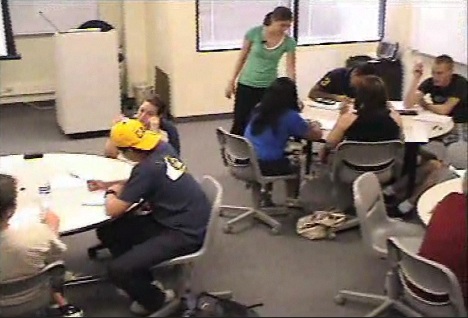 |
In this clip the teacher is having a discussion with a group about whether or not a situation is proportional (click for more details).
In order to help the group come to a conclusion the teacher has them recall the definition and suggests some strategies they can use. She also gives them a demonstration of how to determine whether or not two quantities are proportional.
|
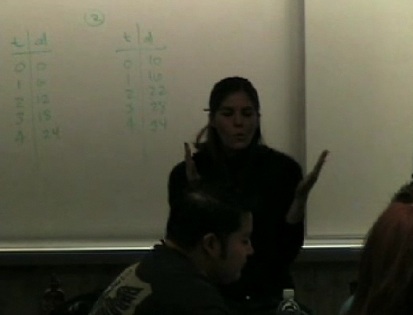 |
In this clip the teacher asks the students to define proportionality (click for more details).
While discussing whether two tables on the board are examples of proportionality, the teacher asks the students to recall the definition of proportionality. She creates a discussion about proportionality and how they can determine whether or not a situation is proportional.
|
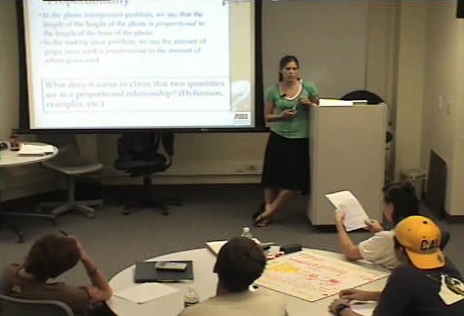 |
In this clip the teacher asks the students to come up with their own definition of what it means for two quantities to be proportional (click for more details).
She has them work in groups to create their own definitions and then has them share their definitions with the class. She uses the student definitions to create a discussion about what the formal definition for the class will be.
|
 |
In this clip the teacher is giving an introduction to the photo enlargement problem and proportionality (click for more details).
This is an example of how the photo enlargement problem can be introduced into the classroom. The teacher attempts to build on their understanding of covariation to introduce proportionality.
|
 |
In this clip the teacher is working with small groups to help guide them through the photo enlargement problem (click for more details).
The teacher is using questioning to help the students think about how to approach the problem. He is helping foster the kind of behavior and participation expected in the classroom.
|
 |
In this clip the teacher is using questioning to help a small group with the photo enlargement problem (click for more details).
This is a nice example of how the teacher uses questioning strategies as students work on the problem. He is helping form the kind of participation he expects over the course of the semester.
|
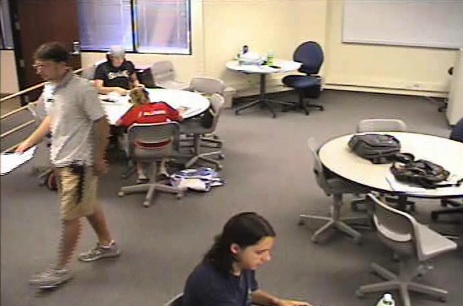 |
This is another example of the teacher using questioning strategies when working with a group on the photo enlargement problem (click for more details).
The teacher also highlights a student response to help ensure that the other members of the group see it as important.
|
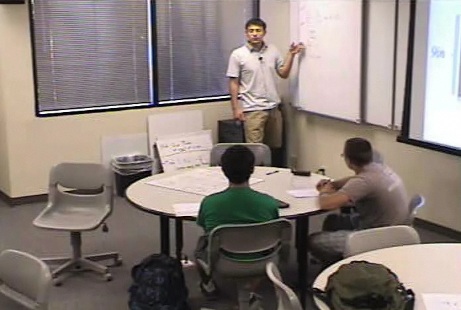 |
After going throug the two main solution methods for the photo enlargement problem, the teacher asks the students how they can generalize (click for more details).
The teacher has help the students understand what it means to generalize the relationship between the base and the height. The students then have to create a formula relating the two.
|
 |
In this clip the teacher uses the summary of the photo enlargement problem to reinforce the relationship between proportionality and covariation (click for more details).
As a class they are discussing the relationship between the height and the base. During the conversation the teacher is constantly pushing the students to verbalize which relationship is staying constant. This is an example of how the photo enlargement problem can be summarized in a way that emphasizes covariation.
|
 |
In this clip the teacher is going over a common difficulty he noticed from a homework problem about enlarging a photo (click for more details).
The teacher noticed many of the students struggled determining which quantities were proportional in the problem. He negotiates a discussion with the students so they can discuss the various quantities involved in the problem and how they are related. As they have this discussion, the teacher is constantly having the students attend to how the quantities co-vary.
|
 |
In this clip the teacher creates a discussion about two different solution methods employed by students while solving the same problem (click for more details).
In working the juice/wheatgrass problem, the teacher gets two different solution methods from students, both resulting in the correct answer. She creates a discussion about both of these methods and points out how they are similar.
|
 |
In this clip the teacher is discussing proportionality in the context of constant speed (click for more details).
This is an opportunity to discuss the concept of proportionality in a context that is familiar to students. The teacher also goes through some basic examples with the students to make sure they understand.
|
 |
In this clip the teacher is discussing proportionality in the context of constant speed (click for more details).
This is a different teacher than in the first clip. She is allowing the students to give suggestions to create their own meaning. She also comes to a point where she realizes the students are struggling and must give them some guidance.
|
 |
In this clip the teacher is having a discussion with a small group about what proportionality is and allows them to use the context of constant speed to explain (click for more details).
The students are working on a constant speed problem, but refer back to the photo enlargement problem in order to describe what proportionality is. This appears to help them think about it in terms of percentage increases.
|
 |
In this clip, the teacher gives a proportional situation and asks the students to justify whether or not it is proportional (click for more details).
The teacher is creating a conversation in which she and the students together will compare proportional and linear situations. She starts with a proportional situation that she will alter in the next two clips to be linear so they can examine the similarities and differences.
|
 |
In this clip the teacher alters the situation from clip 1 to now be linear (click for more details).
Together with the class she discusses how that changes what they had created for the first scenario. They go through the changes to the formula and the graph.
|
 |
In this clip the teacher again alters the situation used in the previous two clips (click for more details).
The new scenario is still linear, but has a different formula than what was created in the previous clip. This brings rise to tranformations of functions which the teacher briefly investigates as they have not yet been covered in the course.
|
 |
The teacher gives the students a problem that is both proportional and linear, then changes it so that it is still linear, but no longer proportional (click for more details).
They begin by discussing whether or not the situation is proportional by using the definition of proportionality. After that discussion, the teacher changes the problem so that the situation has a starting value, thus it is no longer proportional. This again results in a discussion in which they have to use the definition of proportionality to explain why it is not proportional.
|

